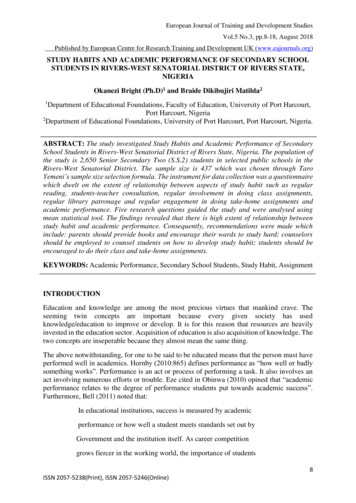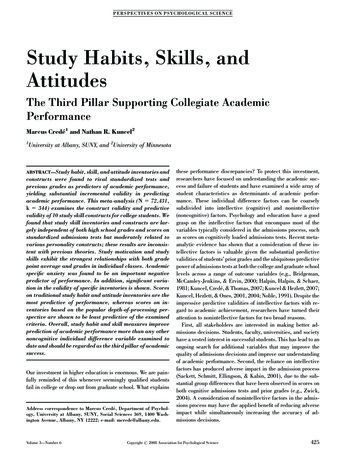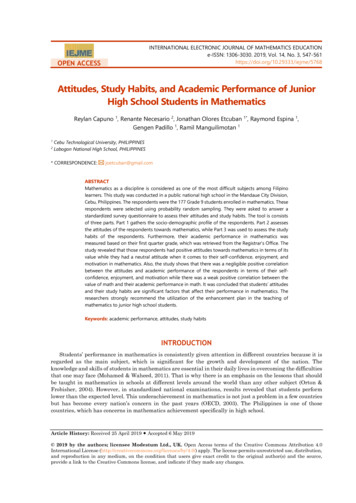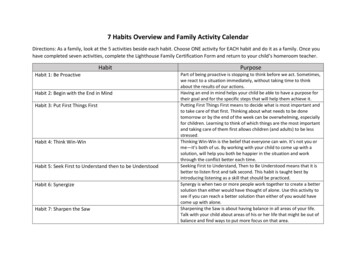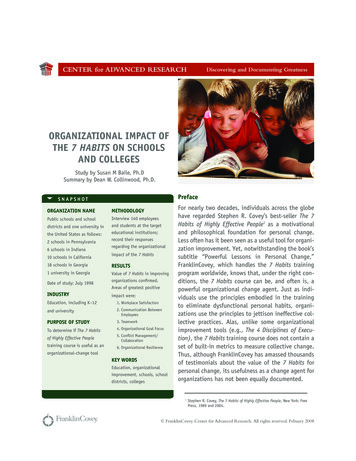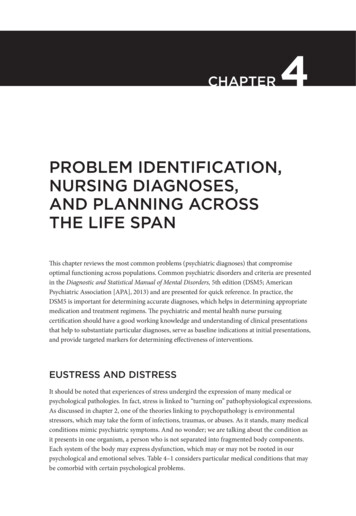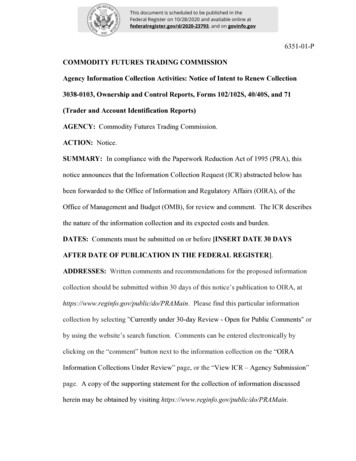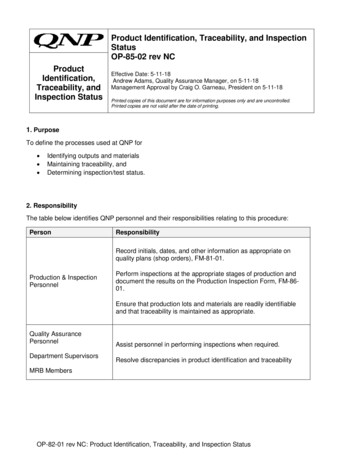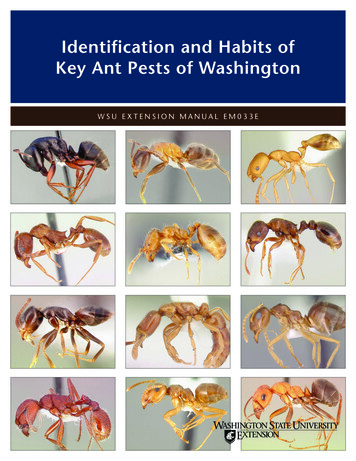
Transcription
Identification and Habits ofKey Ant Pests of WashingtonWSU EXTENSION MANUAL EM033E
Cover images are from www.antweb.org, as photographed by April Nobile.Top row (left to right): Carpenter ant, Camponotus modoc; Velvety tree ant, Liometopum occidentale; Pharaoh ant,Monomorium pharaonis.Second row (left to right): Aphaenogaster spp.; Thief ant, Solenopsis molesta; Pavement ant, Tetramorium spp.Third row (left to right): Odorous house ant, Tapinoma sessile; Ponerine ant, Hypoponera punctatissima; Falsehoney ant, Prenolepis imparis.Bottom row (left to right): Harvester ant, Pogonomyrmex spp.; Moisture ant, Lasius pallitarsis; Thatching ant,Formica rufa.By Laurel Hansen, adjunct entomologist, Washington State University, Department of Entomology; and ArtAntonelli, emeritus entomologist, WSU Extension.Originally written in 1976 by Roger Akre (deceased), WSU entomologist; and Art Antonelli.
Identification and Habits ofKey Ant Pests of WashingtonAnts (Hymenoptera: Formicidae) are an easilyrecognized group of social insects. The workersare wingless, have elbowed antennae, and have apetiole (narrow constriction) of one or two segmentsbetween the mesosoma (middle section) and thegaster (last section) (Fig. 1).anywhere from several hundred to millions ofindividuals. Among the largest ant colonies arethe army ants of the American tropics, with upto several million workers, and the driver ants ofAfrica, with 30 million to 40 million workers. Athatching ant (Formica) colony in Japan coveringmany acres was estimated to have 348 millionworkers. However, most ant colonies probably fallwithin the range of 300 to 50,000 individuals.Ants are one of the most common and abundantinsects. A 1990 count revealed 8,800 species of antshad been described and that number has increasedto more than 14,000. There are still a number ofundescribed ant species in the world. The truenumber is probably more than 30,000.Ants normally have three distinct castes: males,queens, and workers. Males are intermediate in sizebetween queens and workers and can be recognizedby ocelli (simple eyes) on top of the head, wings,protruding genitalia, and large eyes. The solefunction of the male is to mate with a wingedfemale during the nuptial flight.Ants are also one of the most widely distributedof all insect groups. They occur from the Arctictree line to the humid tropics, from Alaska to theextreme tip of South America, to the tip of Africa,Australia, and even to all the islands in the oceans.They are the most abundant of all social insects.The winged female loses her wings soon aftermating and becomes a queen. However, scars wherethe wings were attached remain. Queens usually alsohave ocelli in addition to large compound eyes anda large gaster for egg production.Since there are so many species of ants, and in suchdiverse habitats, it becomes obvious that ants areone of humans’ principal insect competitors. Antsinfest buildings as a nuisance, feed on human foods,and even cause structural damage.The worker, the smallest member of the colony,usually lacks ocelli and is never winged. Workers ofa single species may be of one size (monomorphic)or may vary considerably in size (polymorphic).Large workers are usually called soldiers or majors;very small workers are minors.Ants are also annoying because of their biting orstinging habits. Ant stings are responsible for anumber of human fatalities in the United Stateseach year. The effects of stings on a human dependon the ant species and the sensitivity of the person.Most deaths are caused by a hypersensitive reactionleading to anaphylactic shock.Ants pass through several distinct developmentalstages in the colony: egg, larva, pupa, and adult.The egg is very small (less than 1 mm) and variesin shape according to species. The larva also variesin size and shape, but is usually white and is alwayslegless. The pupal stage looks like the adult, butis soft, white, and motionless; many species areenclosed in a cocoon of a brownish or whitishpapery material produced by the mature larva.General BiologyMany ant colonies are started by a singleinseminated female, called a queen. From thissingle individual, ant colonies can grow to contain1
PetioleHead MesosomaGasterAnts produce winged reproductives usually at onetime of the year (spring or fall, depending on speciesand colony disposition). Colony activity at thetime of reproductive swarming is high. The wingedfemales and males fly from colonies and mate, andshortly afterward the male dies. The inseminatedqueen then builds a small nest, lays a few eggs, andnurtures the developing larvae that soon hatch fromthe eggs. When adult workers appear, they take overthe function of caring for the queen and the larvae,building the nest, and bringing in food for thecolony. Colonies of some species may persist for 20years or more.aAcidoporeNodeElbowed AntennaSince there are so many species of ants withextremely diverse habits it is difficult to outline acommon lifestyle. Some ants are strictly carnivorous,while others may specialize by eating fungi, seeds,or the “honeydew” of other insects. However, mostants that cause annoyance to homeowners areomnivorous and feed on a variety of foodstuffs.ForewingbHindwingVarious ants make their nests in rotting logs, trees, soil,or even live inside the nests of other ants. Since theyare such a diverse group, it is always best to check thehabits of the particular species. Ants that are commonin the Pacific Northwest and occur in and aroundstructures are presented in this publication.Fig. 1. (a) Profile of worker ant; (b) wings from a reproductiveant.Broadly jointed waistThoraxAbdomenIdentificationAnts are often confused with termites byhomeowners. Consider the following features toseparate ants from termites:aAnts1.Strong constriction petiole or “waist” betweenmesosoma and gaster (Fig. 1a).2.Elbowed antennae (Fig. 1a).3.Forewing, when present, much larger thanhindwing (Fig. 1b).4.Workers are various colors and ndwingAbdomen broadly joined to thorax (no waist)(Fig. 2a).Fig. 2. (a) Profile of a worker termite; (b) wings from areproductive termite.Straight antennae (Fig. 2a).2
3.4.pavement ants, harvester ants, Aphaenogaster spp.Both pairs of wings, when present, of aboutequal size (Fig. 2b).4.Workers are whitish and soft-bodied.The following keys will assist in the identificationof common household ants recorded as pests in thePacific Northwest.Ants in the Pacific Northwest that occur aroundstructures are included in four subfamilies of ants:1.Formicinae: carpenter ants, thatching ants,moisture ants, and small honey ants2.Dolichodorinae: odorous house ants and velvetytree ants3.Myrmicinae: pharaoh ants, little black ants,Ponerinae: ponerine antsNote: The first key is for workers. Additional keysare provided for winged females and males. Inselecting worker ants for the key, select the largestants available.Key to workers(identifying many of the characteristics will require use of a hand lens)1) Abdominal petiole composed of one segment (Fig. 3a). 2Abdominal petiole composed of two segments (Fig. 3b) (Subfamily Myrmicinae). 82) Node broad at the apex, rectangular (Fig. 4) (Subfamily Ponerinae). Hypoponera punctatissimaNode not broad at the apex, flattened or pointed (Fig. 1). 33) Tip of gaster with circular acidopore (opening) usually surrounded by a fringe of hairs (Fig. 5a)(Subfamily Formicinae). 4Opening at the end of the gaster slit-shaped, not surrounded by hairs (Fig. 5b)(Subfamily Dolichoderinae). 74) Profile of thoracic dorsum evenly convex (Fig. 6a). carpenter ants, Camponotus spp.Profile of thoracic dorsum not evenly convex, with notch (Fig. 6b). 55) Epinotal spiracle a narrow slit (Fig. 7a). thatching ants, Formica spp.Epinotal spiracle rounded (Fig. 7b). 66) Scape surpassing occipital margin by less than one-third its length (Fig. 8a). moisture ants, Lasius spp.Scape surpassing occipital margin by at least one-third its length (Fig. 8b). small honey ants, Prenolepis imparis7) Node on pedicel flattened when viewed in profile (Fig. 9a).odorous house ants, Tapinoma sessileNode on pedicel vertical when viewed in profile (Fig. 9b). velvety tree ants, Liometopum spp.8) Antenna with 10 segments (Fig. 10a). thief ants, Solenopsis molestaAntenna with more than 10 segments (Fig. 10b). 99) Spines on the epinotum (Fig. 11a). 10No spines on the epinotum (Fig. 11b). pharaoh ants, Monomorium pharaonis10) Rows of long hairs on underside of head (psammophore) (Fig. 12). harvester ants, Pogonomyrmex spp.Short hairs on the underside of head, no psammophore. 1111) Dorsal profile of the mesosoma markedly step-like (Fig. 13a).Aphaenogaster spp.Dorsal profile of the mesosoma even or only slightly indented (Fig. 13b). pavement ants, Tetramorium spp.3
Fig. 3. Profile of abdominal pedicel. (a) One-segment; (b) twosegments.Fig. 7. Profile of epinotum and pedicel. (a) Formica spp.; (b)Lasius spp.Fig. 4. Profile of pedicel and gaster of Hypoponerapunctatissima.aFig. 8. Profile of head and antennae. (a) Lasius spp.; (b)Prenolepis imparis.bFig. 5. Profile and ventral views of tip of gaster. (a)Camponotus spp. (arrow: acidopore); (b) Liometopum spp.(arrow: transverse, slit-like opening).aFig. 9. Mesosoma and gaster. (a) Tapinoma sessile; (b)Liometopum spp.bFig. 6. Mesosoma profile. (a) Camponotus spp.; (b) Lasiusspp.Fig. 10. Antenna. (a) Solenopsis; (b) Pogonomyrmex spp.4
avarious stages of decay, in cavities in sound wood, orin soil beneath stones and wood. Colonies consist ofup to 3,000 workers and several queens. All speciesfeed on seeds, dead and live insects, and otherarthropods. They have been reported to feed onhousehold foods such as cakes, peanut butter, andmeat.bFig. 11. Profile of mesosoma and gaster. (a) Tetramoriumspp.; (b) Monomorium pharaonis.Major concern: These ants are usually onlyan incidental pest for homeowners when thereproductives swarm in late summer to fall. Workershave a weak sting and will bite if a nest is disturbed,but most people consider these minor annoyances.The sting rarely penetrates human skin; bites hurtonly if inflicted in a sensitive area.Camponotus spp. (carpenter ants)Fig. 12. Profile of head, Pogonomyrmex spp.Fig. 13. Profile of the mesosoma. (a) Aphaenogaster spp.; (b)Tetramorium spp.Fig. 15. Camponotus spp., lateral view.Principal Pest Ants of WashingtonCarpenter ant workers (Fig. 15) can be recognizedby their evenly convex thoracic profile. Color isvariable, with black or red and black bicoloredspecies most common. Polymorphic workers rangein size from 6 to 13 mm, which distinguishesthem as one of the largest ant species. Colonies areusually found in logs, trees, or some other woodenstructure. Workers forage for dead or live insects,honeydew, or common household foodstuffs.Reproductives are present in the colony duringwinter and swarm during the first warm days ofspring (March–June, depending on locality). Severalspecies occur throughout the Pacific Northwest.Aphaenogaster spp.Major concern: These ants are considered structuralpests. While they will sometimes start their attackin wood in various stages of decay, they also attacksound wooden structures and can be extremelydamaging. They do not eat wood, but instead clearareas inside the wood in which to raise their brood.Fig. 14. Aphaenogaster spp., lateral view.Most species are brown to reddish-brown, 4–6 mm,and monomorphic. Spines are present on theepinotum. These ants (Fig. 14) nest in wood in5
Remedial measures should include determiningthe location of the colony, removing all infestedmaterial and attendant rotten wood, and replacingit with sound wood. It is important that the locationof the colony be determined, as much undue alarmis caused by sexual forms that wander into homesduring and after swarming but are not established inthe house or doing damage. See EB0818, CarpenterAnts: Their Biology and Control.Formica spp. (Western thatching antand other ants)Fig. 17. Hypoponera punctatissima, lateral view.and have a stinger. The colonies are small, usuallyconsisting of fewer than 100 workers. Nests arelocated in soil or rotten wood. This group, whichwas introduced from subtropical areas, has becomeestablished in urban areas around the PacificNorthwest. Generally only the winged females areencountered as they emerge into a building from asubterranean nest and are attracted to lights. Thestings can be quite painful.Major concern: Winged forms emerging inbuildings can sting people and produce a weltor
Principal Pest Ants of Washington Aphaenogaster spp. Most species are brown to reddish-brown, 4–6 mm, and monomorphic. Spines are present on the epinotum. These ants (Fig. 14) nest in wood in Fig. 14. Aphaenogaster spp., lateral view. various stages of decay, in cavities in sound wood, or in soil beneath stones and wood. Colonies consist of


